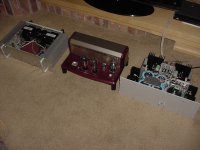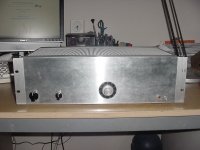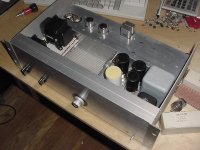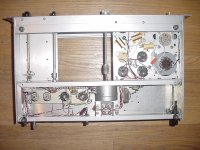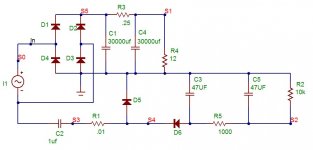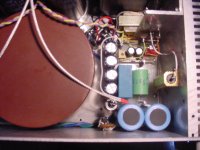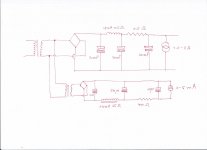There's a spiffy little follower here:
http://www.diyaudio.com/forums/pass-labs/233057-sit-variations.html#post3433106
http://www.diyaudio.com/forums/pass-labs/233057-sit-variations.html#post3433106
There's a spiffy little follower here:
http://www.diyaudio.com/forums/pass-labs/233057-sit-variations.html#post3433106
Spiffy indeed.
Ignorant as i am i have a question though. What is the interest of using a SIT in follower arrangement? I thought that its particular benefit becomes apparent only in gain stage arrangement?
Can somebody help please?
This might be of interest to someone. The attached pic. shows my 'store-bought' Yamamoto A-08S fitted with NOS Cunningham globe 45s, flanked by my SIT creations - 193V L'amp on the left and my power follower design on the right.
A non-scientific 'shoot-out' was conducted over several listening sessions during this past extended week-end.
Bottom line - no clear preference. As with most things audio, it all depends on one's preference/biases, choice of listening material etc. - clear case of 'a chacun son gout'
Ancillary equipment as follows:
Digital front end - Sony SCD-XA777ES
Analog - Thorens TD 124, Rega RB300, Denon 103, Denon AU-320
Phono Stage- Acurus P10 (modified), Mitsubishi DA-P10 (modified)
Line Stage - Euridice (3A/167M with TL 311 outputs) , Mitsubishi DA-P10 (modified )
Speakers - Altec A5, super-tweeter enhanced.
Program material - Sublime to the ridiculous ! ie, Mozart 'Die Zauberflote' - Solti, Beethoven Violin Concertos - Heifetz to 'London Calling' - Clash, 'Marshall Mathers LP' - Eminem.
Concensus only achieved when we reconnected my resident reference system.
A non-scientific 'shoot-out' was conducted over several listening sessions during this past extended week-end.
Bottom line - no clear preference. As with most things audio, it all depends on one's preference/biases, choice of listening material etc. - clear case of 'a chacun son gout'
Ancillary equipment as follows:
Digital front end - Sony SCD-XA777ES
Analog - Thorens TD 124, Rega RB300, Denon 103, Denon AU-320
Phono Stage- Acurus P10 (modified), Mitsubishi DA-P10 (modified)
Line Stage - Euridice (3A/167M with TL 311 outputs) , Mitsubishi DA-P10 (modified )
Speakers - Altec A5, super-tweeter enhanced.
Program material - Sublime to the ridiculous ! ie, Mozart 'Die Zauberflote' - Solti, Beethoven Violin Concertos - Heifetz to 'London Calling' - Clash, 'Marshall Mathers LP' - Eminem.
Concensus only achieved when we reconnected my resident reference system.
Attachments
Clear evidence that the SIT amps sound just like the tube amp.I don't believe ya , without more porn

Clear evidence that the SIT amps sound just like the tube amp.
This might be true. I hope they would have their own character, or at least benefits of both semi and tube.
Just wishing outloud.
By 'no clear preference' I did not wish to imply that the amps all sounded alike or had the same character. Quite the contrary, they all sounded different and in quite surprising ways. On numerous occasions depending on source components and program material, the SIT amps were 'warmer' and 'wetter' than the Yamamoto and in somewhat of a role reversal the Yamamoto had better bass control on some occasions. This was the case on the "Kill You" track on Eminem's Marshall Mathers LP - a severe test of bass transients.
To keep Zen Mod happy attached are some file pics of my Euridice build.
To keep Zen Mod happy attached are some file pics of my Euridice build.
Attachments
Hi nicoch58,
Before I attempt to answer your question , some details are in order - my 193V SIT differs from Mike's design in several aspects. I tried different biasing schemes and settled on self-bias with a by-passed source resistor, which at the time sounded best to me. After the initial novelty of listening to the SIT wore off, I came to the conclusion that the amp was 'warmer' than I liked. There is really no easy way to adjust a self-bias amp, you have to do more than just twiddle a pot, that was when I switched to fixed-bias.
My previous experience with fixed-biasing (tubes) convinced me that unless I was prepared to regulate B+, it was not a good idea just to regulate the bias voltage - best to let both voltages float along together - so it is with the SIT. I used the attached unregulated negative supply circuit suggested by no other than The Master and in doing so eliminated a whole bunch of components including my least-favored IC, the 79xx. So far I have been pleased with the results.
I added a 0.33 ohm source resistor to limit the power-on current surge , prepared to accept the resulting degeneration in exchange for a longer and happier life for the SIT.
The power supply is a CRCLR configuration and I had to use a 20v transformer (Antec AS-4220) to make up for the voltage drop.
In addition to the 2SK82, both SIT amps have following in common :
Input cap. - ERO MKC 1864 4uF 10% 200v
Output cap - four 2200uF 35v Nichicon SE electros., one 10 uF Rifa PHE420, one 1.5uF Sprague Vitamin Q, all caps in parallel.
There is no simple answer to your question . I could live happily with either. The 193V SIT seems to be 'livelier' (function of voltage gain ?) and has plenty of what the Brits call 'pace and rhythm', the Follower SIT is more laid-back although no less dynamic, it is just not as 'frenetic' as the 193V. Both amps are VERY sensitive to source components, more so than any amps I have encountered and as I mentioned, in some circumstances both amps sounded 'tubebier' than the Yamamoto. Both amps are sensitive to bias adjustments and if you have the equipment, you could adjust the distortion spectra to your taste. The Follower SIT has a more benign clipping characteristic than the 193V when both amps are pushed to the limit. I happen to think that not enough research has been done on amp clipping phenomena , which I feel has more relevance than the fixation on distortion spectra, to good sound. But then what do I know ?
Before I attempt to answer your question , some details are in order - my 193V SIT differs from Mike's design in several aspects. I tried different biasing schemes and settled on self-bias with a by-passed source resistor, which at the time sounded best to me. After the initial novelty of listening to the SIT wore off, I came to the conclusion that the amp was 'warmer' than I liked. There is really no easy way to adjust a self-bias amp, you have to do more than just twiddle a pot, that was when I switched to fixed-bias.
My previous experience with fixed-biasing (tubes) convinced me that unless I was prepared to regulate B+, it was not a good idea just to regulate the bias voltage - best to let both voltages float along together - so it is with the SIT. I used the attached unregulated negative supply circuit suggested by no other than The Master and in doing so eliminated a whole bunch of components including my least-favored IC, the 79xx. So far I have been pleased with the results.
I added a 0.33 ohm source resistor to limit the power-on current surge , prepared to accept the resulting degeneration in exchange for a longer and happier life for the SIT.
The power supply is a CRCLR configuration and I had to use a 20v transformer (Antec AS-4220) to make up for the voltage drop.
In addition to the 2SK82, both SIT amps have following in common :
Input cap. - ERO MKC 1864 4uF 10% 200v
Output cap - four 2200uF 35v Nichicon SE electros., one 10 uF Rifa PHE420, one 1.5uF Sprague Vitamin Q, all caps in parallel.
There is no simple answer to your question . I could live happily with either. The 193V SIT seems to be 'livelier' (function of voltage gain ?) and has plenty of what the Brits call 'pace and rhythm', the Follower SIT is more laid-back although no less dynamic, it is just not as 'frenetic' as the 193V. Both amps are VERY sensitive to source components, more so than any amps I have encountered and as I mentioned, in some circumstances both amps sounded 'tubebier' than the Yamamoto. Both amps are sensitive to bias adjustments and if you have the equipment, you could adjust the distortion spectra to your taste. The Follower SIT has a more benign clipping characteristic than the 193V when both amps are pushed to the limit. I happen to think that not enough research has been done on amp clipping phenomena , which I feel has more relevance than the fixation on distortion spectra, to good sound. But then what do I know ?
Attachments
The bolded in your text above is an important solution to bias the PP complementary SIT amp which Mr. Pass demonstrated at BAF 2013.My previous experience with fixed-biasing (tubes) convinced me that unless I was prepared to regulate B+, it was not a good idea just to regulate the bias voltage - best to let both voltages float along together - so it is with the SIT. I used the attached unregulated negative supply circuit suggested by no other than The Master and in doing so eliminated a whole bunch of components including my least-favored IC, the 79xx. So far I have been pleased with the results.
Hi nicoch58,
Before I attempt to answer your question , some details are in order - my 193V SIT differs from Mike's design in several aspects. I tried different biasing schemes and settled on self-bias with a by-passed source resistor, which at the time sounded best to me. After the initial novelty of listening to the SIT wore off, I came to the conclusion that the amp was 'warmer' than I liked. There is really no easy way to adjust a self-bias amp, you have to do more than just twiddle a pot, that was when I switched to fixed-bias.
My previous experience with fixed-biasing (tubes) convinced me that unless I was prepared to regulate B+, it was not a good idea just to regulate the bias voltage - best to let both voltages float along together - so it is with the SIT. I used the attached unregulated negative supply circuit suggested by no other than The Master and in doing so eliminated a whole bunch of components including my least-favored IC, the 79xx. So far I have been pleased with the results.
I added a 0.33 ohm source resistor to limit the power-on current surge , prepared to accept the resulting degeneration in exchange for a longer and happier life for the SIT.
The power supply is a CRCLR configuration and I had to use a 20v transformer (Antec AS-4220) to make up for the voltage drop.
In addition to the 2SK82, both SIT amps have following in common :
Input cap. - ERO MKC 1864 4uF 10% 200v
Output cap - four 2200uF 35v Nichicon SE electros., one 10 uF Rifa PHE420, one 1.5uF Sprague Vitamin Q, all caps in parallel.
There is no simple answer to your question . I could live happily with either. The 193V SIT seems to be 'livelier' (function of voltage gain ?) and has plenty of what the Brits call 'pace and rhythm', the Follower SIT is more laid-back although no less dynamic, it is just not as 'frenetic' as the 193V. Both amps are VERY sensitive to source components, more so than any amps I have encountered and as I mentioned, in some circumstances both amps sounded 'tubebier' than the Yamamoto. Both amps are sensitive to bias adjustments and if you have the equipment, you could adjust the distortion spectra to your taste. The Follower SIT has a more benign clipping characteristic than the 193V when both amps are pushed to the limit. I happen to think that not enough research has been done on amp clipping phenomena , which I feel has more relevance than the fixation on distortion spectra, to good sound. But then what do I know ?
Many thanks audiong for sharing.
Ever since i read post #879 by ilimzn i could not refrain from thinking about the problematic of bias adjustments.
These days i think about transformer coupling to the secondaries of the main transformer.
Simulation with PSU Designer II shows that the Bias is up more quickly than B+.
I do not know what will happen when switching of.
Anyway, as long as nobody has serious doubts? I shall order the small transformer 2x 115V / 2x24V next week and give it a try.
Attachments
audiong. juma's thread 'VFET PP amp' shows a psu like that you showed [bias tracking]; but for complementary SITs. Please show the reference which The Master taught. Thank you and kind regards.The bolded in your text above is an important solution to bias the PP complementary SIT amp which Mr. Pass demonstrated at BAF 2013.
Hello Mr. Rothacher. I was unaware that you were entitled a befitting The Master. A simple statement like audiong wrote about SIT bias tracking plus a reference [please show] is like a L'Amp turning on. Now I see the light. Thanks and best regards,My thanks for pointing out someone else's work is to be nitpicked. Now I remember why I love this hobby so much.
- Home
- Amplifiers
- Pass Labs
- L'Amp: A simple SIT Amp
